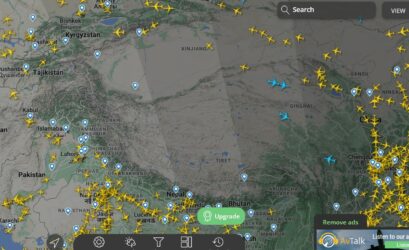Commercial airplanes usually have cruising altitude of anywhere between 33,000 feet to 42,000 feet. At this height, it really does not matter whether you are flying over a desert, ocean, plains or mountains. However, despite this high altitude, there are areas in the world that planes usually avoid. One such region is the Tibetan plateau, which remains largely devoid of commercial planes. Just take a look at the picture below and you will see almost no planes in the Tibetan region.

It makes us wonder why planes do not fly over Tibet. It is not a conflict zone or a restricted area, so why planes avoid flying over Tibet? To answer these questions, here are some things we need to understand.
Lack of safe descend altitude
There are many reasons why planes fly at a high altitude. One reason is that they need a safe altitude to descend down in case of an emergency. For example, planes are required to descend to around 10,000 feet in case of situations such as cabin depressurization. As the average altitude of Tibetan plateau is around 14,000 feet, planes will not be able to reach a safe altitude in emergency situations.
Oxygen supply available on planes is for only around 10-15 minutes. So, unless the plane descends to an altitude where oxygen supply is available, passengers will be at great risk of hypoxia. To ensure safety of passengers, planes usually avoid flying over the Tibetan region.
High turbulence
Air turbulence is experienced by most flights during their journey, even when the weather may be perfectly fine. However, such standard air turbulence can be easily handled by the pilots. But when flying over mountainous regions such as Tibet, turbulence can be a lot more.
It can also come from different directions, which can make flying a nightmare for pilots. Mountainous regions are also known for unpredictable weather patterns. Risk of high turbulence is another reason why planes do not fly over Tibet.
Jet fuel freezing
Jet fuel has freezing temperature of around -47° Celsius. When flying over mountainous regions such as Tibet, there is a risk of jet fuel freezing. Short flights may not be impacted, but continued exposure can be a risk.
Even if some amount of ice crystals are formed, it can theoretically clog the fuel supply. Aviation systems such as sensors could also be impacted by exposure to extremely low temperatures over prolonged periods. Planes usually avoid flying over Tibet because there’s high risk of jet fuel freezing.
Last but not least, there are limited airports available in the area in case an emergency landing is required. Due to extreme terrain and weather conditions, search and rescue operations can also take a long time. In view of these factors, commercial flights usually avoid flying over Tibet.
 Newspatrolling.com News cum Content Syndication Portal Online
Newspatrolling.com News cum Content Syndication Portal Online






